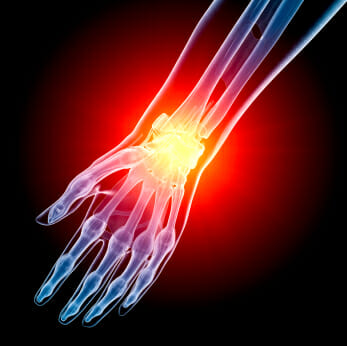The wrist is a complex joint in which 15 different bones meet, each one with its own specific function. The role of each bone within the wrist is important, and if a problem or injury occurs in any one of them, it can affect the entire movement of the joint. The radius is one of the bones in the forearm that connects the elbow to the other bones in the wrist, and fractures of the radius are extremely common. When the term “broken wrist” is used, it usually refers to fractures of the distal part of the radius, which is where it meets the wrist. These injuries may be serious and in some cases require surgery, but regardless of what treatment is used for your broken wrist in New York City, a course of physical therapy will be essential to ensure that you have a complete recovery.
The radius is located on the thumb side of the wrist and is the larger of the two bones that make up the forearm. Along with the other forearm bone—the ulna—these forearm bones permit movements of the elbow, hand and wrist, and the distal radius takes on a great deal of the load experienced at the wrist. This is one of the main reasons the distal radius is so vulnerable to fractures. Distal radius fractures are the most common fractures in the arm and are some of the most common fractures that occur throughout the entire body. Of all fractures seen in the emergency room, about one-sixth are distal radius fractures.
The vast majority of distal radius fractures occur after someone falls and lands with their hands outstretched, which is often called a “fall on an outstretched hand,” or FOOSH. Falls in sports like soccer and basketball, as well as biking, skateboarding or rollerblading accidents can all lead to a distal radius fracture if the person lands with enough force. Older individuals with osteoporosis are also at an increased risk for distal radius fractures because their bones are more fragile and can therefore break from even a minor fall.
After experiencing a distal radius fracture, a person will usually experience immediate pain, swelling, tenderness and bruising. Many individuals will also have a wrist that hangs in an odd or bent way (called a deformity), as well as difficulty moving the wrist and fingers. Upon examination, these injuries are usually divided into the following three types:
- Type 1: a “nondisplaced” fracture in which the bone is broken but still rests in a normal position
- Type 2: a fracture where a fragment of bone is shifted from its normal position
- Type 3: the most serious type of fracture, with multiple breaks of the bone or bones
How physical therapy can help you recover from your broken wrist in New York City
In most cases, type 1 and 2 fractures are treated non-surgically with a cast being worn for a period of time until the bone heals, while type 3 fractures are usually treated with a surgical procedure to repair the fractured bone. But regardless of which type of treatment is used, a course of physical therapy will be necessary to help the patient regain the motion, function and strength of the wrist. To give you an idea of what this process looks like, here are some highlights of a typical treatment program for a broken wrist in New York City:
- While the wrist is still in a cast: during this period of time, your physical therapist will likely prescribe some gentle exercises the keep the shoulder, elbow and fingers moving so that these parts of the arm don’t lose their abilities while the wrist is immobilized
- After the cast is removed/after surgery: once the cast is removed, the wrist usually feels stiff and the arm feels weak, so your physical therapist will prescribe treatments to address these issues and restore the function of your wrist with the following:
- Hands-on techniques (manual therapy) to help your joints and muscles to move more freely with less pain
- Ice and heat therapy to address the pain in your wrist
- Stretching and strengthening exercises to help you regain your ability to move your wrist normally
- Exercises that are specific to your sport or physical activity of choice to help you return to the things you love
A broken wrist in New York City is often a serious injury that can set you back for a while, but seeing a physical therapist during the recovery period will help ensure that you’re making your way back to full strength in the safest and fastest manner possible. So if you’ve recently broken your wrist, we strongly recommend contacting us today to find out how we can help you. Contact Dynamic Sports Physical Therapy at 212-317-8303 to schedule an appointment, or click here for more information on distal radius fractures.

